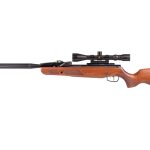Airgun care and maintenance is an important subject for any airgun owner. Today, we’ll look at some options for taking care of your break barrel or spring-powered airgun. Let’s get started.
To Clean or Not to Clean – The Barrel
There’s a great debate on how and how often you should clean your airgun barrel. Our suggested rule of thumb is really simple. If it ain’t broke, don’t fix it. Too often, we’ve found a gun that had been shooting pretty well started shooting worse after cleaning the barrel. Why does this happen? Surely, cleaning the barrel would only improve things, right?
There may be more than one reason for this phenomenon, but one of the most common focuses on the barrel becoming seasoned. Once a barrel is “seasoned,” it tends to shoot better. Seasoning may happen by simply shooting it until the accuracy improves, or it may help to really scrub it with a bronze brush and JB bore paste. Regardless of how it gets done, once you have the barrel seasoned and shooting well, you really don’t want to mess with it. But it goes against our nature not to clean the barrel. So when is the “right time” to clean it?
If your airgun is shooting well, then leave it be. But if you start seeing the accuracy slowly degrade (the “slowly” part is very important), it might be time to clean the barrel. You can find what you need in cleaning and maintenance. Please note that if your airgun likes to be seasoned by shooting pellets, you’ll need to give it some time to reseason after cleaning it. The more you shoot and learn your airgun, the more you’ll understand what’s needed to keep it in top shooting form. Trigger time is your best friend.
What If Accuracy Degrades Suddenly?
As mentioned above, it’s reasonable to go for the barrel cleaning solution when things go south slowly. But if your accuracy drops suddenly, it’s probably not the barrel. Here are some things you’ll want to check, and really, you should check these every time you sit down at the bench to shoot.
First up are your stock screws. Loose stock screws are the primary cause of break barrel / spring airgun accuracy issues. When your action is not held securely in the stock, it leads to inconsistent recoil, which in turn causes random changes in your point of impact. Now, this only applies to guns that were accurate to begin with.
After you check your stock screws, give your scope screws a once over. If your action slopping around in the stock causes shifts in your point of impact, imagine what having a loose scope will do to your groups. This happens more often than you think. The unique recoil of break barrel airguns is really hard on every mounting point. So, check all your screws, and check them often.
What About the Inside?
Regarding care and maintenance for the internals, you should lean on the manufacturer’s specific guidelines for your airgun. But here are some general guidelines that may help.
There are three main areas of break barrel internals to consider. Two are the same regardless of the powerplant, and the other IS the powerplant, and its care will vary based on if it’s a gas ram or a traditional metal spring. Let’s start with the two that don’t vary.
The trigger group is the first area that may need attention now and then. There’s not a lot going on here, but checking for any dust and dirt could make the trigger pull better. Also, a touch of lube may improve your overall shooting experience.
Next is the compression chamber. The compression chamber is what makes the power to drive the pellet out of the barrel. This is done via a piston topped with a seal that’s driven by the powerplant (we’ll get to that next). Keeping the seal in top shape is key. Historically, seals were made from leather and had to be lubed regularly. This changed many years ago as manufacturers transitioned to polymer materials. Some seals have lubricant baked right in, and all you need to do is shoot regularly to keep them working well. Others need a few drops of silicone, like RWS Chamber Lube, every 200 to 300 shots. You’ll need to reference your manual or contact your manufacturer to know the right method for your airgun.
Lastly, we come to the powerplant. If your break barrel uses a gas ram, then you are good to go. There’s nothing really to tune, tweak, or lube. As long as the ram keeps its pressure, you should have good performance.
If you have a traditional metal spring, then you’ll want to take a look at Tune-In-A-Tube. This is a great lube that delivers many benefits. First of all, it lubes the spring, piston tube, and piston, which makes things operate more smoothly. The second benefit is its dampening properties. Traditional metal spring guns can have an annoying vibration or “buzz.” The tacky nature of Tune-In-A-Tube takes that all away. It’s like putting rubber bands on a bell. If it can vibrate and resonate, then it just makes a thud when you hit it. The contrast between a spring gun with and without the Tune-In-A-Tube is pretty dramatic, and it just makes the gun shoot better and more consistently.
Let’s Wrap It Up
So, if you’re rocking a break barrel airgun, you now have some ideas of how to keep it in top shape. From cleaning the barrel to tackling the dreaded “buzz.” And if you have more questions, please give us a call, as we are always ready to help.
